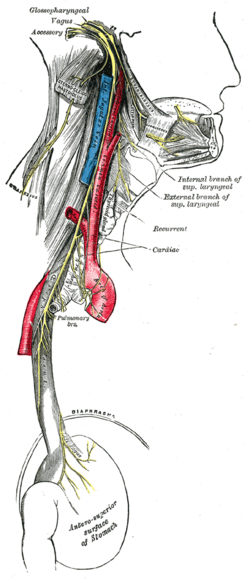External laryngeal
| Superior laryngeal nerve | |
|---|---|

Plan of upper portions of glossopharyngeal, vagus, and accessory nerves. ("Laryngeal" labeled at lower right.)
|
|

Course and distribution of the glossopharyngeal, vagus, and accessory nerves. (Branches visible in upper right.)
|
|
| Details | |
| Innervates | larynx |
| Identifiers | |
| Latin | nervus laryngeus superior |
| Dorlands /Elsevier |
n_05/12566088 |
| TA | A14.2.01.160 |
| FMA | 6239 |
|
Anatomical terms of neuroanatomy
[]
|
|
The superior laryngeal nerve is a branch of the vagus nerve. It arises from the middle of the inferior ganglion of vagus nerve and in its course receives a branch from the superior cervical ganglion of the sympathetic nervous system.
All intrinsic laryngeal muscles except the cricothyroids are innervated by the recurrent laryngeal nerve. The cricothyroid muscles are innervated by the superior laryngeal nerve.
The superior laryngeal nerve consists of two branches: the internal laryngeal nerve (sensory), which supplies sensory fibers to the laryngeal mucosa, and the external laryngeal nerve (motor), which innervates the cricothyroid muscle.
The recurrent laryngeal nerve gets its name from the fact that it loops below the aorta on its way to the intrinsic muscles of the larynx. The left recurrent laryngeal nerve passes under and around the aorta on its way to the larynx, whereas the right recurrent laryngeal nerve passes under and around the subclavian artery. Because the aorta is inferior to the subclavian artery, the left recurrent laryngeal nerve is a bit longer than the right recurrent laryngeal nerve. However, there is no discernible effect on the timing of neural impulses to the muscles these two nerves serve. By comparison with the recurrent laryngeal nerves, the superior laryngeal nerve takes a more direct route on the way to the cricothyroid muscles.
The superior laryngeal nerve descends, by the side of the pharynx, behind the internal carotid artery, and divides into two branches —the external laryngeal nerve and the internal laryngeal nerve.
The external laryngeal nerve is the smaller, external branch. It descends on the larynx, beneath the sternothyroid muscle, to supply the cricothyroid muscle. The external branch functions to tense the vocal cords by activating the cricothyroid muscle, increasing pitch. The external laryngeal nerve gives branches to pharyngeal plexus and the superior portion of the inferior pharyngeal constrictor, and communicates with the superior cardiac nerve behind the common carotid artery.
...
Wikipedia
